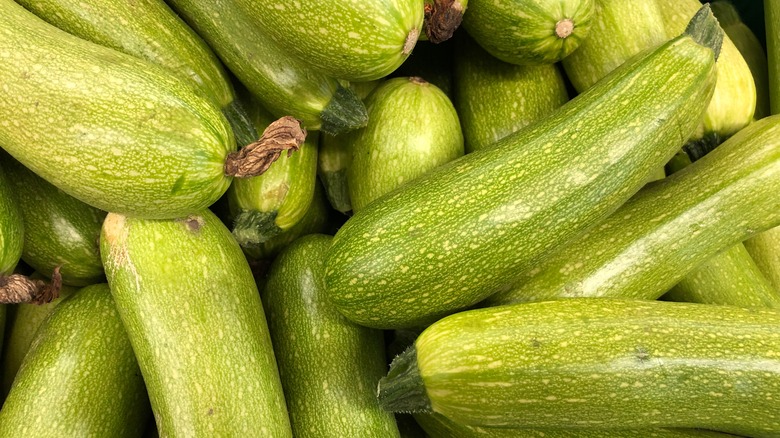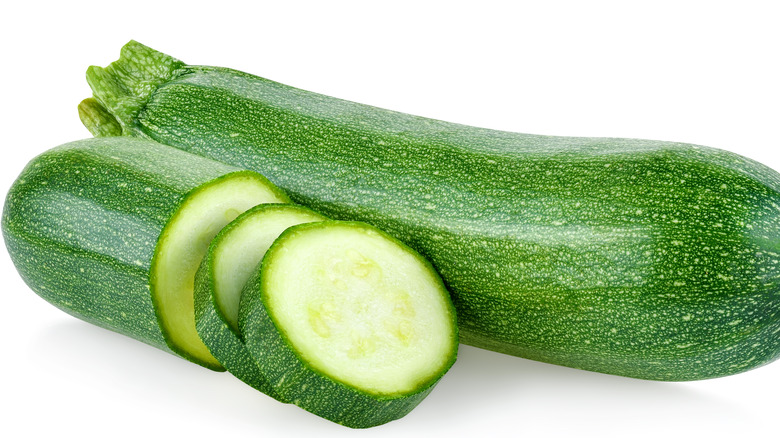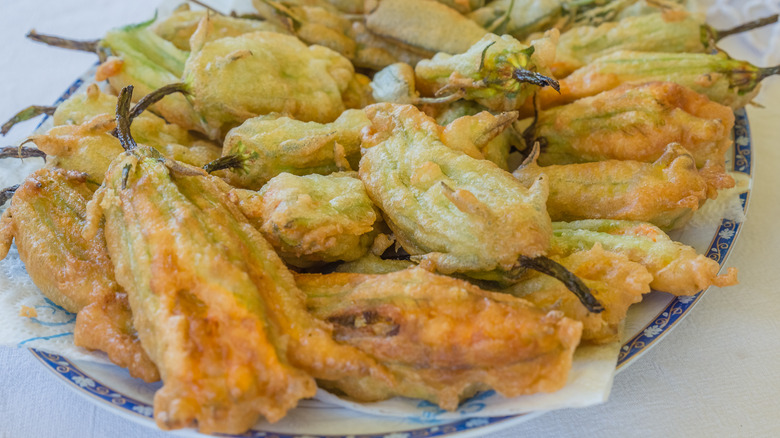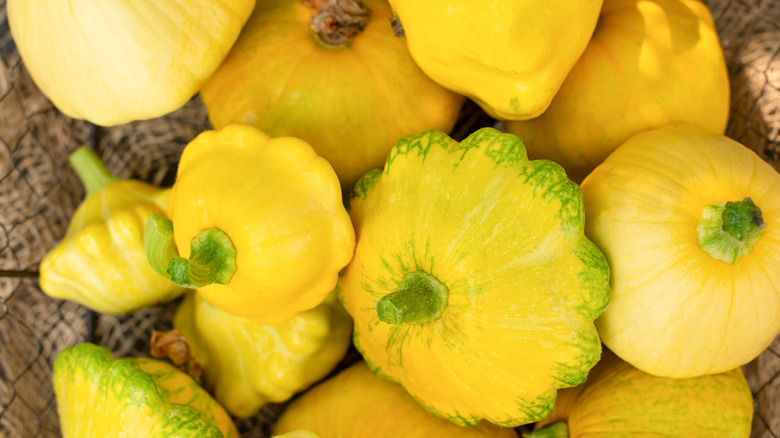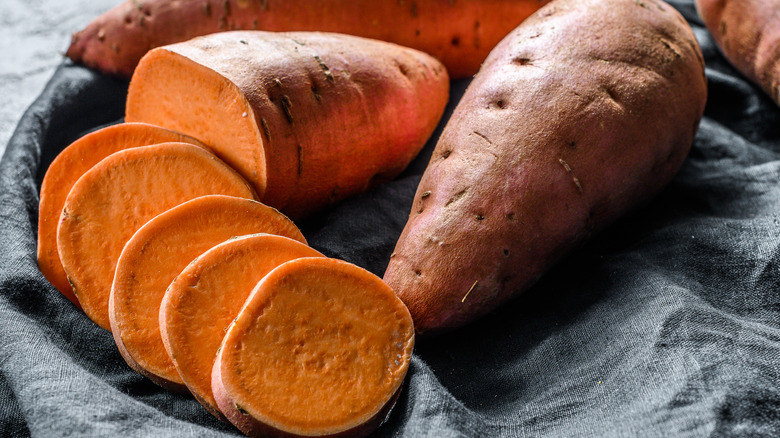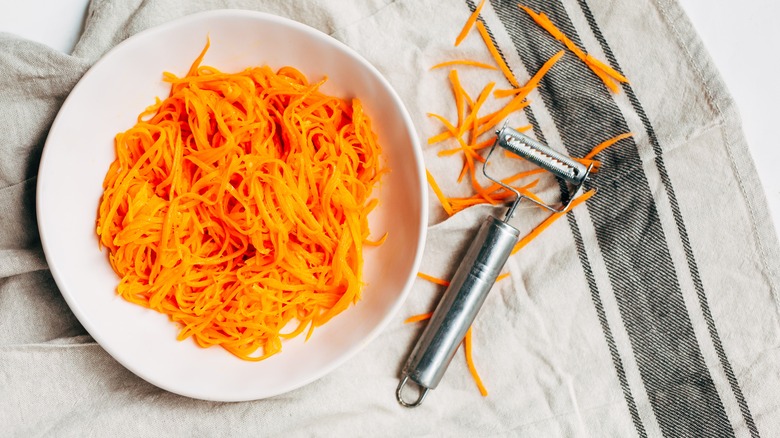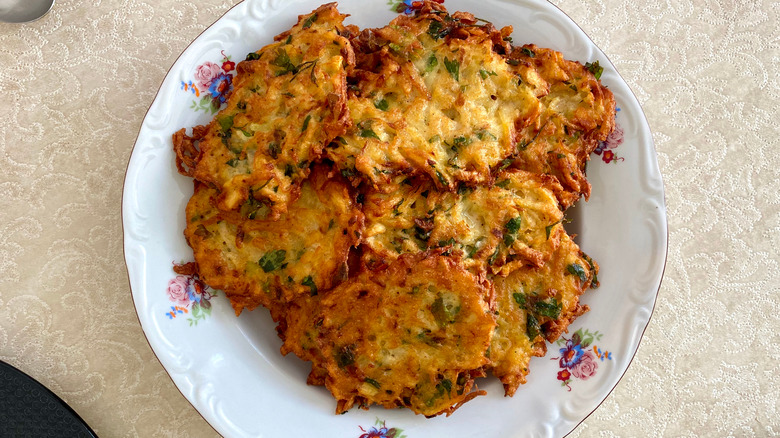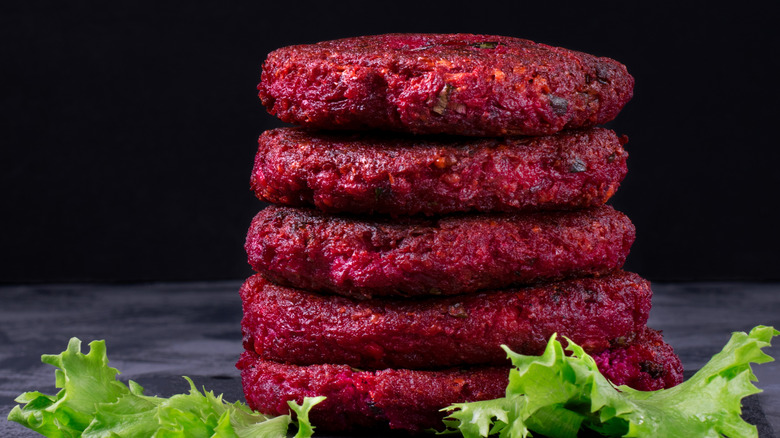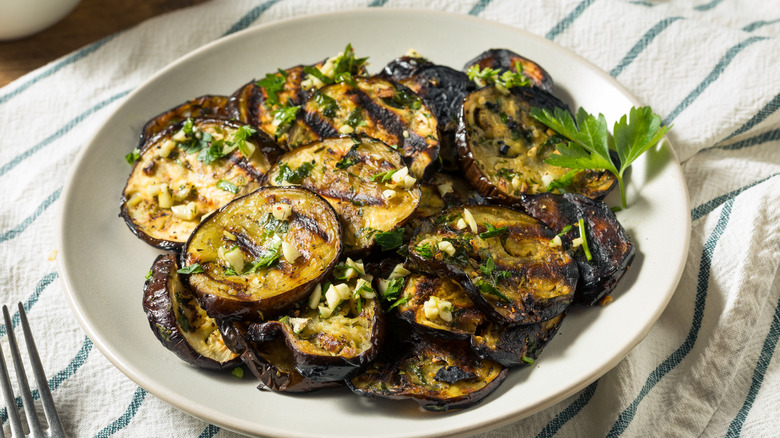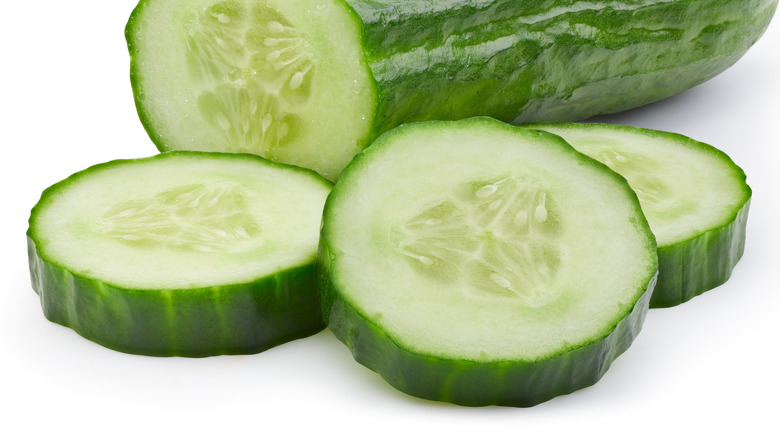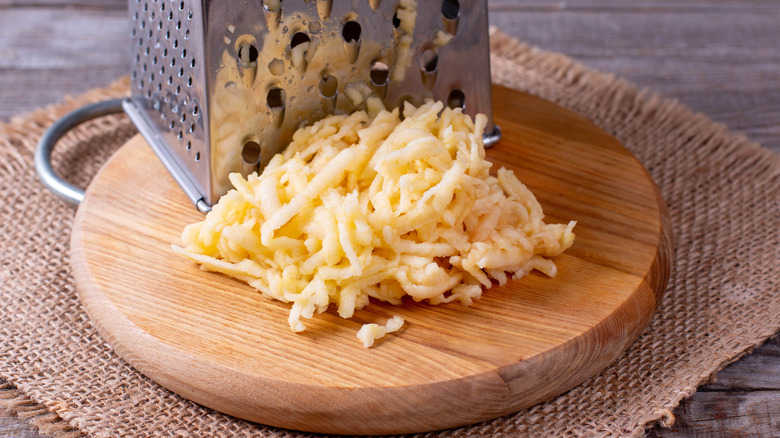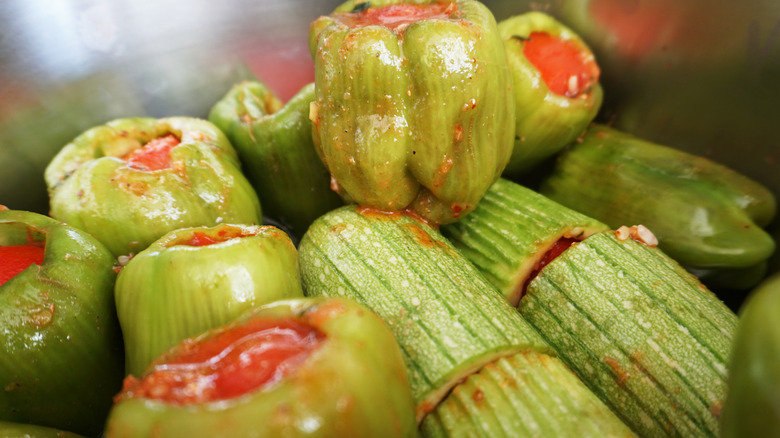10 Alternatives To Zucchini
Depending on where you live, you might know zucchini (Cucurbita pepo) as a courgette. Whichever you call it, they are the same summer squash that's used in both savory and sweet dishes. Zucchini usually has thick green skin but also comes in a golden variety with pale, creamy-colored flesh.
So, what does zucchini taste like? Its flavor is somewhat mild, earthy, and grassy. It is precisely this mild flavor that makes zucchini such a versatile ingredient. You can add it raw to salads, sprialize it to make "zoodles," sauté it up as a side dish or even bake it into bread. The possibilities are nearly endless. Be careful of overripe zucchini, though. It can get bitter — decidedly not tasty.
Besides its versatility, people may choose zucchini for its nutritional value. This tasty squash is a good source of vitamins A and C, as well as potassium and B6. Zucchini is also low in carbs, fat, sugar, and calories, which makes it appealing to many. Because zucchini is 94% water (via the USDA), its high water content is not only great nutritionally but one of the reasons zucchini works so well in many recipes, especially baked goods.
That said, there are still situations in which you might want or need to replace zucchini. For that reason, we've compiled a list of stellar alternatives to zucchini.
Why replace zucchini?
Though it is a very well-liked ingredient, there are legitimate and necessary reasons to replace zucchini. Firstly, everyone has different likes and dislikes. There's nothing shameful about disliking zucchini (in fact, some would say this is the correct opinion). Perhaps you like zucchini, but you've simply run out and don't have time to run to the store.
And then, of course, you may have a zucchini allergy. One study conducted at the University Hospital of Zurich found that people can be allergic to zucchini but react negatively to it if they're allergic to similar compounds in other foods. They believe there is a high likelihood of cross-reactivity with other members of the same botanical family, Cucurbitaceae, which includes watermelon and cucumber.
It's important to note that zucchini's botanical name, Cucurbita pepo, is shared by other summer squash and even pumpkins; they're all cultivars of the same species. Further, the Servicio de Alergología and Servicio de Inmunología in Madrid state that Cucurbitaceae fruits are one of the most allergy-causing fruits in America. Talk to your doctor if you suspect you have a zucchini allergy.
Swap in Pumpkin
Obviously, this alternative is not for those with a squash allergy, but if you're not a zucchini fan and haven't got any on hand, or if it's out of season — pumpkin is here to save the day. Since the two squashes are so closely related, it's no surprise they share a similar earthy flavor. However, pumpkin is sweeter and a little fruitier.
Since pumpkin tends to get a bit mushier than zucchini, we recommend using it as a replacement in baked goods, such as quick bread. Instead of using zucchini in this spiced zucchini bread recipe, you can shred the pumpkin as you would your zucchini. What makes this work so well is pumpkin's high moisture content. At 91%, it's almost as high as zucchini's (via the USDA).
Have you ever had fried zucchini blossoms (such as in this sweet corn-stuffed zucchini blossom recipe)? Well, what about fried pumpkin blossoms? That's right; you can totally eat pumpkin blossoms. Per the folks at Healthline, pumpkin blossoms are rich in antioxidants and vitamin A. Note: to ensure that nature can do its thing and produce more squash, you should only cook male squash blossoms, and the same holds for pumpkin blossoms. Squash blossoms also make a great addition to quesadillas and salads.
If you're really in the mood for a fried bloom but are avoiding squash, daylilies are a viable option (via PBS).
Opt for other squash
We promise that not every alternative on this list is another squash, but they are such a good alternative for zucchini. Especially considering you can substitute either patty pan or summer squash for zucchini in virtually any dish.
Since botanically they are the same species, yellow summer squash and zucchini may seem almost the same, but they're not identical — so what's the real difference between them? The first noticeable difference is the color (although yellow zucchini does exist). But whereas zucchini has a nearly uniform thickness from top to bottom, yellow summer squash has a noticeably thinner neck and a wider bottom. It also has more seeds than zucchini does.
Pattypan is another summer squash that tastes nearly identical to zucchini. The only trick with subbing this one in for zucchini is its shape (pattypans kind of look like flying saucers). You may need to get a little creative when cutting, or you could look at pattypan's shape as an advantage — a plate of grilled pattypans certainly has a lot of eye appeal.
Sub in sweet potato
Our next alternative to zucchini is sweet potato. While starchier and sweeter than zucchini, its relatively high moisture content (80%, according to the USDA) makes it a formidable swap in baked goods, such as quick bread. Unlike some other zucchini alternatives, sweet potatoes are sturdier and don't as readily fall apart when cooked, which means they can easily replace sliced zucchini in recipes.
If you're craving some fresh spiralized vegetable "noodles" a la zoodles, why not try using sweet potatoes instead? (Would those be spoodles?) Common mistakes with zucchini noodles also apply to making other vegetable noodles. The number one thing to remember is that this isn't wheat pasta. In fact, you can even combine your veggie noodles with wheat pasta.
Sweet potatoes are delicious in gratins, casseroles, soups, chilis, and fritters. Sweet potatoes contain nutrients such as potassium, magnesium, and vitamins B and C. However, this root tuber might not be the best alternative for you if you're watching your carbs, considering they contain 15 net carbs.
Exchange for carrots
Carrots are a kitchen staple, which is just one reason they're an excellent choice for a zucchini alternative. According to the USDA, carrots are a good source of calcium, potassium, and vitamins A and C. Carrots are superb in ratatouille. Not just because they add such a beautiful color to the already gorgeous dish, but because of how well they roast. The reason roasted vegetables taste so good is caramelization, and carrots are no exception. In other savory applications, carrots make good veggie "noodles" and are an excellent zucchini replacement in soups and curries.
If you're interested in sweets, carrot quick bread is perhaps even more common than zucchini quick bread, so that's a natural choice. Never use pre-shredded carrots for your baked goods; we don't add veggies and fruits to desserts just to sneak in nutrients for our kids. At 88% water, carrots add much-needed moisture to your baking.
Put potatoes in it
Fried zucchini comes in all shapes, forms, and cuisines. You can fry zucchini into chips (breaded or not) and fries. Then, there are fritters. Per Dishes Origins, zucchini fritters' popularity dates back to Ottoman times, and they're still eaten all over the Middle East and the Mediterranean.
In the United States, if there's any vegetable known for being delicious when fried, it's the potato. Like zucchini, it comes in various forms (after all, there's even a difference between potato pancakes and latkes.)
We can guess what you're thinking. It might not seem revolutionary to serve potato chips, french fries, or fritters. However, if you use the spices or accouterments meant for zucchini, they become something special. For example, Middle Eastern zucchini fritters are seasoned with mint, dill, parsley, and green onions, which are not in your average potato latke or pancake.
Likewise, another popular way to serve zucchini in the Middle East and the Mediterranean is fried with a garlic yogurt dip. Try serving your next round of oven fries with garlic yogurt. You won't even miss the ketchup.
Root for root vegetables
For better or for worse, zucchini finds itself in many plant-based dishes, especially as a meat substitute in veggie burger patties. What's a zucchini-averse vegetarian to do? Beetroot is a fantastic substitute in this case, not only for taste but for color (it's why the very popular Beyond Meat burger uses beet juice in its burger recipe). But you don't have to go to the store to make a beet burger. It's as simple as grains, beets, legumes, spices, and binding ingredients.
If you've found yourself with a soup recipe for which you need a zucchini alternative, try using celeriac or parsnips. If you've never had these vegetables, you should know that they have a deeper flavor than zucchini. Celeriac is celery root and does taste a bit like the plant's stalk but earthier. Parsnips resemble cream-colored carrots but are less sweet and can be a bit spicy. As such, these are great options if you'd like to add a bit of a kick to your soups.
Engage with eggplant
Whether together or separately, eggplant and zucchini often find themselves in the same dishes, making eggplant a seamless zucchini substitute. You can even decide which to use based on the nutrient profile you'd like. If you want a more caloric food with higher fiber and carbs, you're better off going with eggplant (via the USDA).
Eggplant has a very similar texture to zucchini when cooked, so it's an easy and quick replacement for pasta dishes, grilled side dishes, or veggie sandwiches. According to Dishes: Origins, eggplant fritters have been popular since the Ottoman Empire and are still prevalent in Greece and other countries in the region. The Spanish are also known for their berenjenas con miel de caña (batter-fried eggplant served with molasses).
The only places where you probably don't want to use eggplant as a zucchini alternative are baking and raw applications. Purdue University says that while eating raw eggplant is not necessarily dangerous, some people may be sensitive to it, and it has a bitter flavor when uncooked.
Cook with cucumber
While not a squash, cucumber is in the same family as zucchini, so allergy warnings apply here. Cucumbers have an even higher water content than zucchini does — 95%, according to the USDA. Both fruits are often used in salads, so if you don't have any zucchini on hand or don't like its taste, cut up a fresh cucumber for your next summer salad.
What you may not have known is that you can cook cucumbers. For instance, this charred cucumbers with turmeric crema recipe is a worthy substitute for a zucchini side dish. If you'd rather stick to salads, use cucumber instead of zucchini in this grilled corn and summer squash salad recipe. The cucumbers' crispness and subtle sweetness will go perfectly with the grilled corn.
With only 3 net carbs, cucumber is an excellent alternative to zucchini if you want to stay in the low-carb realm. That means they're another outstanding alternative to zoodles if your goal is avoiding carbs.
Add an apple
Wait? What's a fruit doing on this list of alternatives for zucchini? Well, technically, zucchini and most of these alternatives are also fruits. However, apples are already common in a couple of places where you'll often find zucchini — quick breads and salads.
Another reason to consider using apples instead of zucchini is if you're trying to eat seasonally. While it's true that you'll find both zucchini and apples year-round in most U.S. groceries stores, their peak seasons are different. Zucchini is best in summer, whereas apples are the most delicious in the fall.
So, come autumn, consider transforming your zucchini-carrot bread recipe into apple-carrot bread. Here, we recommend shredding the apples as you would the zucchini in the regular recipe. Though applesauce or purée is often used as an egg substitute, that would slightly change the dry to wet ingredient ratio. Although, if you'd like to use applesauce instead of the eggs in your recipe, be sure to use about ¼ cup of applesauce per egg. You can also add apple slices to your salads instead of zucchini chunks, along with stuffing them.
Go with green pepper
Whether you call them dolma, dūlma, or dolmades, vegetables stuffed with meat are a classic in the Middle East, Eastern Europe, and Greece. While they became popular during the Ottoman Empire, they may originate back to an ancient Greek dish of stuffed fig leaves, according to Analida's Ethnic Spoon.
In modern times, zucchini dolma is one of the most popular versions (via Britannica). Green pepper is a great option instead. You should use smaller peppers when making green pepper dolma, or your dish may be bitter.
The true star of the show here is your stuffing. There are two types of dolma stuffing: meat and vegetarian. They are both rice-based, but the way they are served is quite different. The meat-stuffed dolma is served warm, while the veggie ones are served at room temperature.
The dish's name, dolma, comes from the Turkish word dolmak, which means "to fill," and the people of the region have found their fill of vegetables to stuff. While green pepper may be a go-to due to its accessibility for veggie and meat fillings, it is far from the only vehicle for dolma. You can use eggplant (dried or fresh), tomatoes, grape leaves, cabbage, squash blossoms, apples, or even quince.
